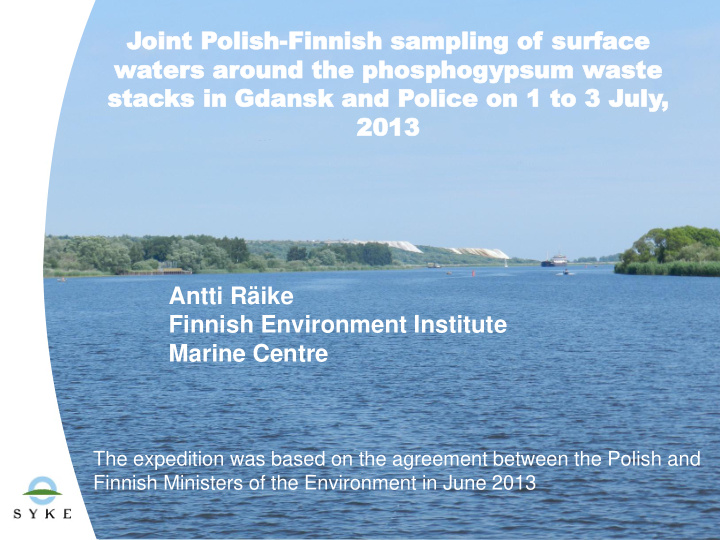



Joint P oint Polish olish-Finn Finnish samp ish sampli ling ng of of surf surfac ace e water ters s ar arou ound nd the the ph phosp ospho hogyp ypsu sum waste aste stac stacks in ks in Gdan Gdansk sk an and P d Police olice on on 1 t 1 to 3 J o 3 Jul uly, , 2013 2013 Antti Räike Finnish Environment Institute Marine Centre The expedition was based on the agreement between the Polish and Finnish Ministers of the Environment in June 2013
Aim of the study ● Find out the role of two Polish phosphogypsum stacks as a pollution source of the Baltic Sea ● The main focus of the study was on phosphorus and phosphate concentrations, but also other parameters were included The Baltic Sea Gdansk Police
Study methods ● Sampling and field studies 1.- 3.7.2013 ● Water quality ○ Gdansk 10 sampling stations ○ Police 7 sampling stations ○ Parameters (all together 17): conductivity, total phosphorus, phosphate phosphorus, aluminium, iron, calcium, fluoride, manganese, potassium, sulfate, sulfur, total nitrogen, ammonium, nitrate, pH, cadmium, nickel ○ Samples were analysed both in Polish and Finnish laboratories ● Hydrology ○ Field studies ○ No flow measurements
Gdansk phosphogypsum stack ● Disposal started 1972 ● Disposal ended 2009 ● Area 34 ha ● Estimated amount of phosphorus of the stack: ○ 42 500 t ● Nearest watercourse: The Dead Vistula ○ Distance 50 m ○ The Dead Vistula has been blocked from the Vistula by a dam: nearly no freshwater flow ● Distance to the Baltic Sea 6 km
Gdansk: Water quality in the stack area ● Really high phosphorus concentrations ● 1,5 km south from the stack still high concentrations ● Phosphorus concentrations in the Dead Vistula are at Phosphate P the same level as in Other P the Gulf of Finland anoxic bottom waters
Gdansk: Water quality results ● Phosphate phosphorus concentrations near the stack nearly 5 times higher The Baltic Sea than those close to the sea ● Total phosphorus concentrations 3 times higher ● This clearly indicates the Stack Phosphate P influence of the stack Other P ● Without knowledge of flow conditions estimation of export to the Baltic Sea is impossible
Police phosphogypsum stack ● Disposal started 1970 ● Disposal continues ● Area 180 ha ● Estimated phosphorus amount ○ 213 000 t ● Nearest water course: The Odra ○ Distance to the river >150 m ● Distance to the Baltic Sea 10 km (Bay of Szczecin) ● More developed water protection system than in Gdansk (including e.g. a WWTP)
Police sampling stations ● 5 sampling stations in the River Odra ● 1 sampling station in a ditch where treated wastewater is discharged into the The stack Odra ● An island in the Odra divides flow: The WWTP amount water flowing X between the stack and the island is unknown River flow divides
Police water quality results ● Phosphorus concentrations increase when river water passes the stack ● Polish monitoring results indicate the same thing ● Increase in concentration was 28% including loading from the WWTP ● Water flow is unknown: It is impossible to estimate phosphorus export Phosphate P Other P
Conclusions ● Polish and Finnish Laboratory analyses were comparable ● Gdansk: The exceptional high phosphorus concentrations in the Dead Vistula can only originate from the phosphogypsum stack ● Police: Increase in total phosphorus concentrations downstream the stack may indicate leaching ● Gaps in knowledge of hydrological conditions in both places. Therefore it is impossible to estimate loading to the Baltic Sea. ● Recommendation: More research on hydrological conditions are needed in both places. This would enable reliable estimation of the potential phosphorus load into the Baltic Sea caused by the stacks.
Recommend
More recommend